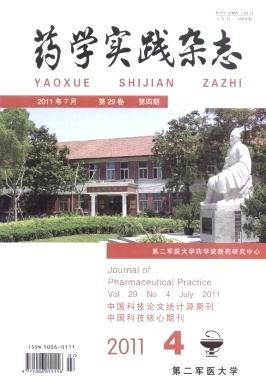DONG Zhao-hua, SHEN Jia-jie, ZHANG Yi-han, SUN Hua-jun. Survey of similarity of drug trade names and registered trade names[J]. Journal of Pharmaceutical Practice and Service, 2011, 29(4): 306-308,311.
| Citation:
|
DONG Zhao-hua, SHEN Jia-jie, ZHANG Yi-han, SUN Hua-jun. Survey of similarity of drug trade names and registered trade names[J]. Journal of Pharmaceutical Practice and Service, 2011, 29(4): 306-308,311.
|
Survey of similarity of drug trade names and registered trade names
- 1.
the thepartment of pharmacy, the 404 People's Liberation Army Hospital, Weihai, Shandong Provience 264200,China
- 2.
the department of pharmacy, Changhai Hospital, the second military medical university, Shanghai 200433, China
- Received Date: 2011-02-22
- Rev Recd Date:
2011-03-18
-
Abstract
Objective To describe the factors of confusions between drug trade names and drug registered names that might lead to medication errors. Methods Drug trade names data are collected from the shared database at State Food and Drug Administration website. The drug names are matched to find out if they were sound-alike or look-alike. Results 7 323 trade name records were collected and 3 462(47.3%) of them were those one trade name for one drug products. Further experiment indicates that 10 groups trade names among the records were different international nonproprietary names that share one trade name with each other. 70 groups were look-alike and 122 groups were sound-alike. 316 of 384 randomly selected trade names were registered. Some registered names were the same as some trade names but for different international nonproprietary name drugs respectively. Conclusion The factors that different names share one drug, different drugs share one name, sound-alike names and look-alike names are common, which is thought to be the contributing cause of medication errors. More attention should be paid on drug trade names to minimize the risk of wrong-selecting, wrong-dispensing and wrong-administrating drugs. Regulation should be established on designing appropriate drug names as well.
-
References
|
[1]
|
曹 健,仲小伟,赵文畅. 药品名称混乱对安全用药的危害及对策[J]. 湖南医科大学学报(社会科学版),2010,12(3):330. |
|
[2]
|
王 辉,李 晶. 相似名称药物的分析比较与安全使用[J]. 中外医疗,2009,(17):169. |
|
[3]
|
张晓哲. 关于药品商品名和药品商标"两名合一"的思考[J]. 中国工商管理研究,2009,(7):39. |
|
[4]
|
Lambert BL, Lin SJ, Tan H. Designing safe drug names[J]. Drug Saf,2005,28(6):495. |
|
[5]
|
U.S. Department of Health and Human Services. Guidance for Industry Contents of a Complete Submission for the Evaluation of Proprietary Names[EB/OL]. (2010-02)/[2011-01-11] http://www.fda.gov/downloads/Drugs/GuidanceComplianceRegulatoryInformation/Guidances/UCM075068.pdf . |
|
[6]
|
Health Products and Food Branch. Guidance For Industry Drug Name Review: Look-alike Sound-alike (LA/SA) Health Product Names[EB/OL]. (2005-10-27)/[2011-01-10]http://www.hc-sc.gc.ca/dhp-mps/brgtherap/applic-demande/guides/drugs-drogues/lasa_premkt-noms_semblables_precomm-eng.php. |
|
[7]
|
李 涛."感冒药"进入品牌时代——央视公布"中国感冒药市场研究"大型调查[J]. 中国工商,2002, (7):110. |
|
[8]
|
王 莉,邓 勋,贺 帅,等. 高血压患者药物品牌内涵响应对用药选择的影响[J]. 今日药学,2010, 20(5):35. |
|
[9]
|
The UK's Medicines and Healthcare products Regulatory Agency . Narrow therapeutic index drug: prescribe and dispense by brand name[EB/OL]. (2009-12-14)/[2011-01-10] http://www.mhra.gov.uk/Safetyinformation/Safetywarningsalertsandrecalls/Safetywarningsandmessagesformedicines/Monthlylistsofinformationforhealthcareprofessionalsonthesafetyofmedicines/CON068166. |
|
[10]
|
杨 波,阎素兰. 齐普夫定律的汉语适用性研究及其在自动标引中的应用[J]. 情报理论与实践,2004, 27(3):252. |
|
[11]
|
韩英杰. 药品未注册商标的使用权[J]. 中华商标,2008, (9):19. |
|
[12]
|
刘小林,张丽莹,孟旭晖,等. 采用"品管圈"方法提高门诊药房药学服务品质的探讨[J]. 药学与临床研究,2010,18(4):395. |
|
[13]
|
黄乐珊,郑师明,严鹏科,等. 门诊药房处方调配差错分析及防范措施[J]. 中国药业,2009,18(11):42. |
|
[14]
|
Filik R, Price J, Darker I, et al. The influence of tall man lettering on drug name confusion: a laboratory-based investigation in the UK using younger and older adults and healthcare practitioners[J]. Drug Saf,2010,33(8):677. |
-
-
Proportional views

-







 DownLoad:
DownLoad: